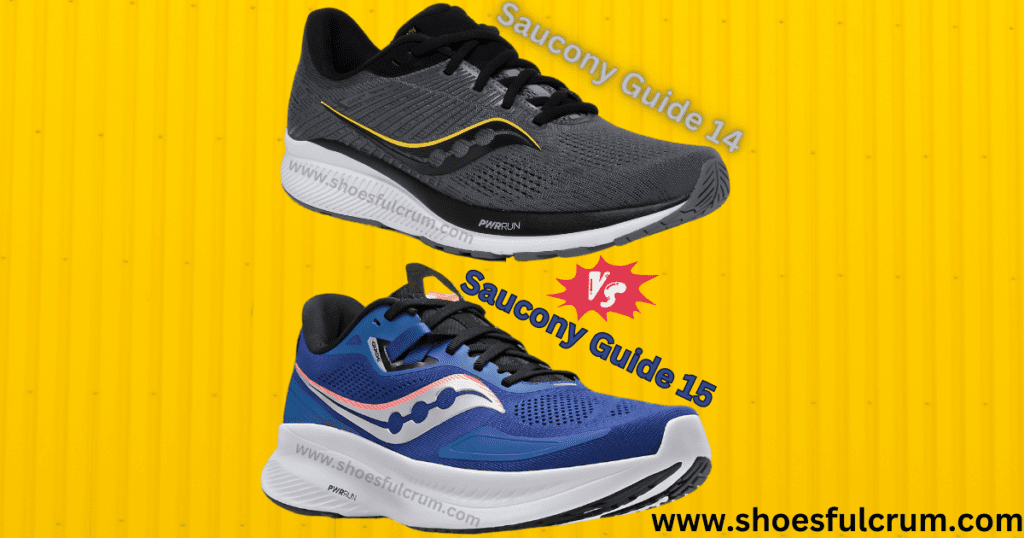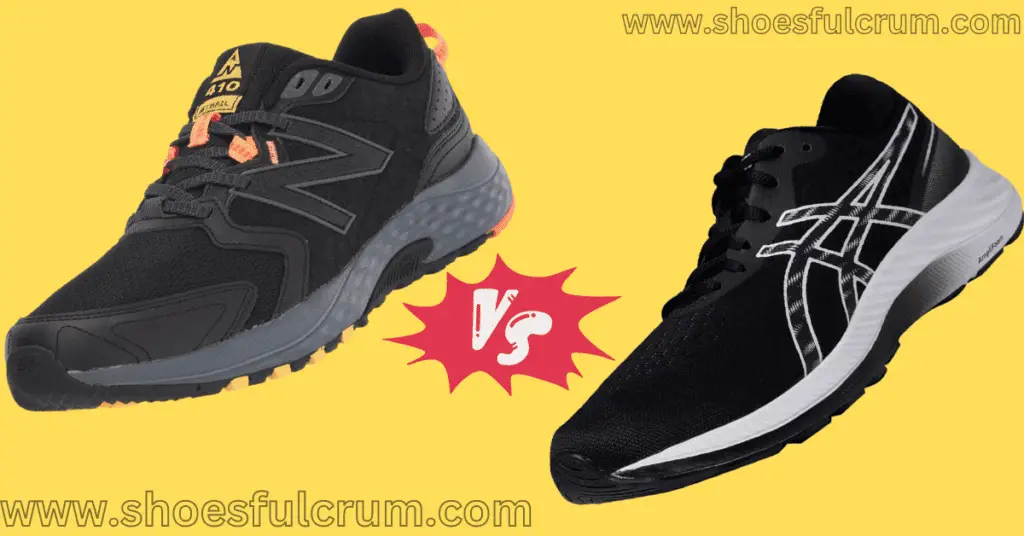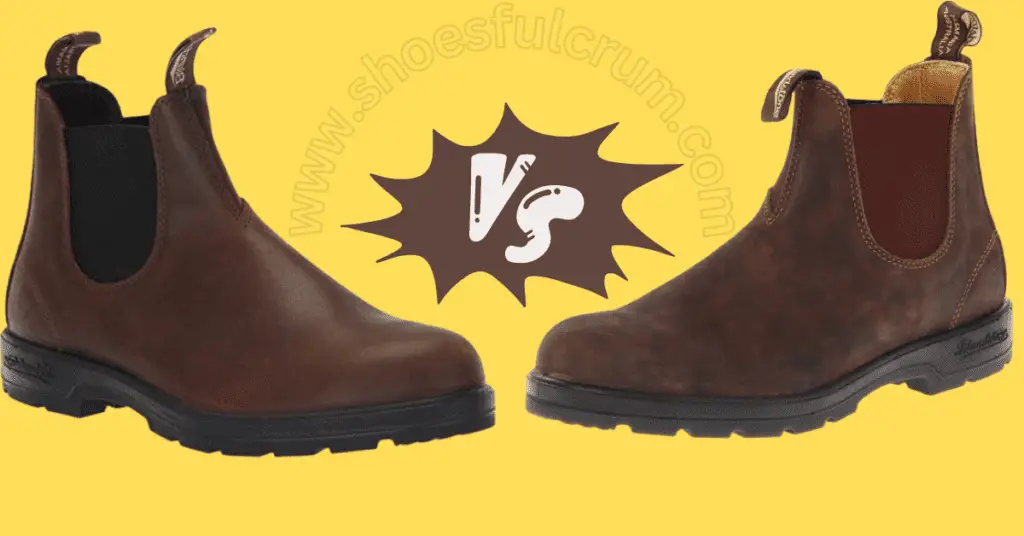When I first laced up a pair of Saucony Guide 14 shoes, I was immediately impressed by their stability and cushioning. Guide 14 provided me with the support I needed to conquer long distances while ensuring a comfortable and responsive ride.
Now, with the release of the Saucony Guide 15, I couldn’t resist trying out the latest iteration of this beloved series. From the moment I slipped my feet into Guide 15, I noticed a significant difference. The shoe felt lighter, offering a more effortless stride without compromising on cushioning.
When it comes to finding the ideal running shoes, then you require a shoe that can match your speed, give the proper assistance, and provide cushioning to push you ahead with every mile.
As a brand known for its dedication to innovation and performance, Saucony has consistently delivered footwear that exceeds expectations.
But what sets these two models apart? How does Guide 15 build upon the success of its predecessor, Guide 14?
In this comprehensive analysis, I will thoroughly examine all aspects, ensuring that you have all the details necessary to make a well-informed choice.
Main Differences: Saucony Guide 14 VS 15
To make the decision-making process more enjoyable and easy, I present to you an exciting comparison table that highlights the key differences between Saucony Guide 14 VS 15.
| Features | Saucony Guide 14 | Saucony Guide 15 |
|---|---|---|
| Weight | Moderate: 10.2 oz (289 g) | Lightweight: 9.9 oz (280 g) |
| Upper | Engineered Mesh with Synthetic Overlays | Improved Engineered Mesh with Synthetic Overlays |
| Midsole | PWRRUN cushioning | Upgraded PWRRUN cushioning |
| Outsole | Durable Rubber with Tri-Flex Design | Durable Rubber with Tri-Flex Design |
| Stability | GuideRails technology for enhanced stability | Enhanced GuideRails technology for stability |
| Pronation Control | Medial Post and GuideRails for pronation support | Medial Post and GuideRails for pronation support |
| Cushioning | Responsive and Balanced | Responsive and Balanced |
| Breathability | Good | Good |
| Fit Options | Standard and Wide | Standard and Wide |
| Sizing Range | Men: 7-15 (Regular and Wide) | Men: 7-15 (Regular and Wide) |
| Women: 5-12 (Regular and Wide) | Women: 5-12 (Regular and Wide) | |
| Water Resistance | No | Enhanced Water Resistance |
| Arch Support | Moderate | Moderate |
| Flexibility | Moderate | Moderate |
| Durability | Durable Construction | Durable Construction |
| Suitable for | Daily training and long-distance running | Daily training and long-distance running |
| Recommended Foot Type | Neutral and Mild Overpronation | Neutral and Mild Overpronation |
Also, Check Out: Saucony Hornet VS Jazz: Which Is Best For Running?
Upper Of Saucony Guide 14 VS 15

The upper of a running shoe plays a crucial role in providing comfort, support, and breathability.
When comparing the Saucony Guide 14 and Guide 15, it’s essential to examine the design and features of their uppers to understand how they contribute to the overall running experience.
Upper Construction
Saucony Guide 14
When it comes to the upper construction of the Saucony Guide 14, Saucony has taken comfort and breathability to the next level.
The upper is crafted using a combination of engineered mesh and FlexFilm overlays, which create a lightweight and supportive structure that adapts to the shape of your foot.
The engineered mesh offers a breathable and flexible feel, allowing for proper airflow to keep your feet cool and dry during your runs. This feature is especially beneficial on hot summer days or intense training sessions when your feet tend to sweat more.
The mesh also provides a snug and secure fit, reducing the chances of discomfort or irritation caused by excessive movement inside the shoe.
Saucony Guide 15
Continuing the tradition of excellence, the Saucony Guide 15 brings notable upgrades to its upper construction. The engineers at Saucony have incorporated the latest technologies and materials to create an even more comfortable and secure fit.
The upper of the Guide 15 features a refined engineered mesh that offers improved breathability and flexibility. It allows for optimal airflow, keeping your feet fresh and cool throughout your runs.
The mesh is strategically designed with different patterns and densities, providing targeted support and stretch where needed.
Support And Stability
Saucony Guide 14
To enhance the overall support and stability, Saucony 14 has incorporated FlexFilm overlays strategically across the upper.
These overlays are fused onto the mesh, providing targeted support in key areas of the foot.
The result is a secure fit that locks your foot in place, preventing unnecessary sliding or shifting during your runs.
Saucony Guide 15
Guide 15 utilizes 3D-printed overlays to further enhance the stability and support. These overlays are strategically placed to provide structure and support in key areas of the foot.
They reinforce the upper, offering a secure fit that minimizes unwanted movement and promotes a more efficient stride.
Important Point
Both the Saucony Guide 14 and 15 excel in providing a comfortable and supportive upper.
Guide 14 features a combination of engineered mesh and FlexFilm overlays, while Guide 15 incorporates refined engineered mesh and FORMFIT technology.
Also, Check Out: Hoka Gaviota VS Clifton: Which Is Best For Road Running?
Midsole And Flexibility Of Saucony Guide 14 VS 15

The midsole is an essential element that plays a crucial role in providing cushioning, support, and overall responsiveness to enhance your running experience.
PWRRUN Foam Midsole
Saucony Guide 14
The Guide 14 features Saucony’s PWRRUN foam midsole, which delivers a plush and responsive feel.
This cushioning technology offers a good amount of shock absorption, reducing the impact on your joints and muscles during your runs.
The PWRRUN foam is designed to provide a soft landing and a springy toe-off, contributing to a more efficient stride.
Saucony Guide 15
The Guide 15 incorporates Saucony’s updated PWRRUN+ foam, which provides an even more luxurious and responsive cushioning experience.
The PWRRUN+ foam used in the Guide 15 offers a softer and more energetic ride. It enhances the cushioning and responsiveness of the shoe, allowing for a comfortable yet dynamic running experience.
The plushness of the foam helps alleviate fatigue, making it ideal for longer runs or those seeking extra cushioning.
FORMFIT Technology
Saucony Guide 14
One notable feature of Guide 14’s midsole is the FORMFIT technology.
This technology ensures a personalized fit and enhanced comfort by adapting to the shape and contours of your foot.
It helps distribute pressure evenly, reducing the chances of discomfort or hot spots.
Saucony Guide 15
Building upon the success of its predecessor, the Saucony Guide 15 takes the midsole technology to the next level.
Similar to Guide 14, Guide 15 also features the FORMFIT technology in its midsole.
This technology ensures a customized fit that adapts to your foot, providing individualized support and comfort throughout your runs.
Flexibility
Saucony Guide 14
The Saucony Guide 14 strikes a balance between flexibility and stability.
The engineered mesh upper and flexible midsole allow for natural foot movements during your runs.
This flexibility is crucial for a smooth and efficient stride, allowing your feet to move naturally without feeling restricted.
Saucony Guide 15
With Guide 15, Saucony continues to prioritize flexibility for an enhanced running experience.
The updated engineered mesh upper and the responsive midsole work in harmony to provide a flexible and adaptive feel. This flexibility allows your feet to move naturally while maintaining the necessary support and stability.
The Saucony Guide 15’s flexibility is beneficial for runners who appreciate a more unrestricted and fluid stride.
It accommodates the natural movements of your foot, promoting a comfortable and efficient running experience.
Breathability Of Saucony Guide 14 VS 15
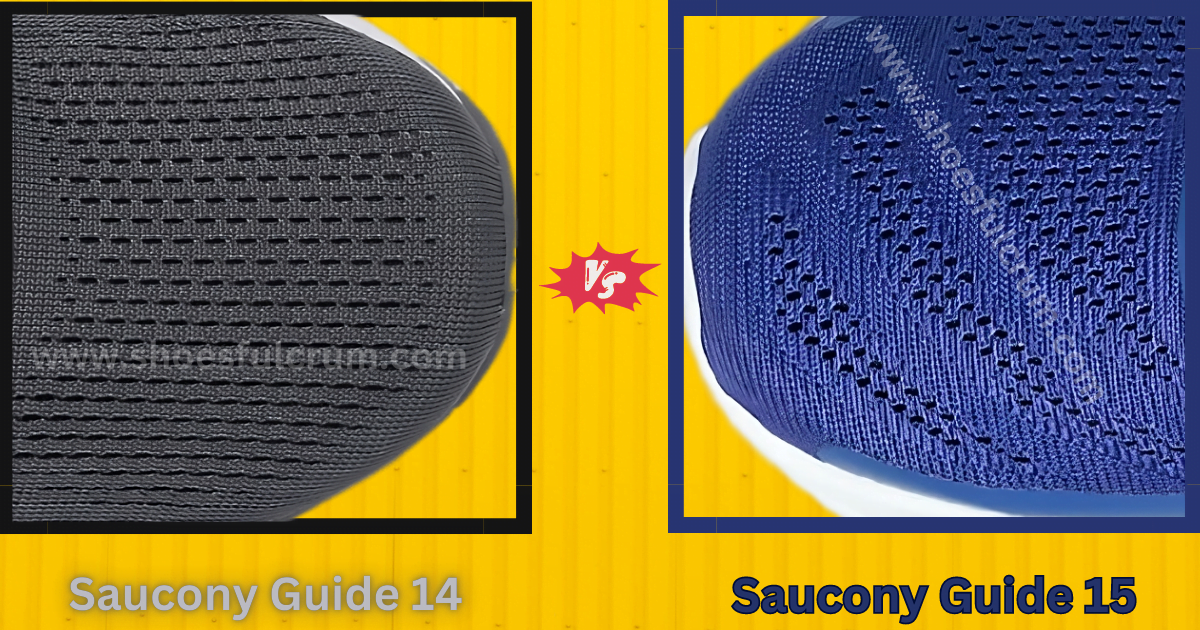
When considering running shoes, it’s important to prioritize breathability as it plays a vital role in ensuring your comfort and enhancing your overall running experience.
Saucony Guide 14
The Saucony Guide 14 utilizes an engineered mesh upper that allows for optimal airflow.
This mesh material is designed with strategically placed perforations that promote air circulation within the shoe. As a result, heat and moisture generated during your runs can escape, keeping your feet cool, dry, and comfortable.
The breathable nature of the Guide 14’s upper is particularly beneficial during longer runs or intense workouts when your feet tend to sweat more.
By allowing air to flow freely, the shoe helps prevent excessive moisture buildup, reducing the likelihood of blisters and discomfort caused by damp feet.
Saucony Guide 15
With the Saucony Guide 15, Saucony has continued to prioritize breathability to ensure optimal performance and comfort.
The Guide 15 features an updated and refined engineered mesh upper that takes breathability to the next level.
The engineered mesh in Guide 15 is designed with improved breathability characteristics.
It incorporates a combination of breathable materials and strategic ventilation zones that facilitate airflow and heat dissipation. This enhanced breathability helps to keep your feet cool and dry, even during the most demanding runs.
In addition to the advanced mesh design, the Saucony Guide 15 also features an updated sock liner that contributes to the overall breathability of the shoe.
The sock liner wicks away moisture and enhances ventilation, further promoting a comfortable and fresh environment for your feet.
The improved breathability of the Saucony Guide 15 makes it an excellent choice for runners who prioritize temperature regulation and moisture management during their runs.
Whether you’re tackling long distances or pushing your limits in high-intensity workouts, Guide 15 ensures that your feet stay cool and dry throughout.
Outsole Design And Traction Of Saucony Guide 14 VS 15
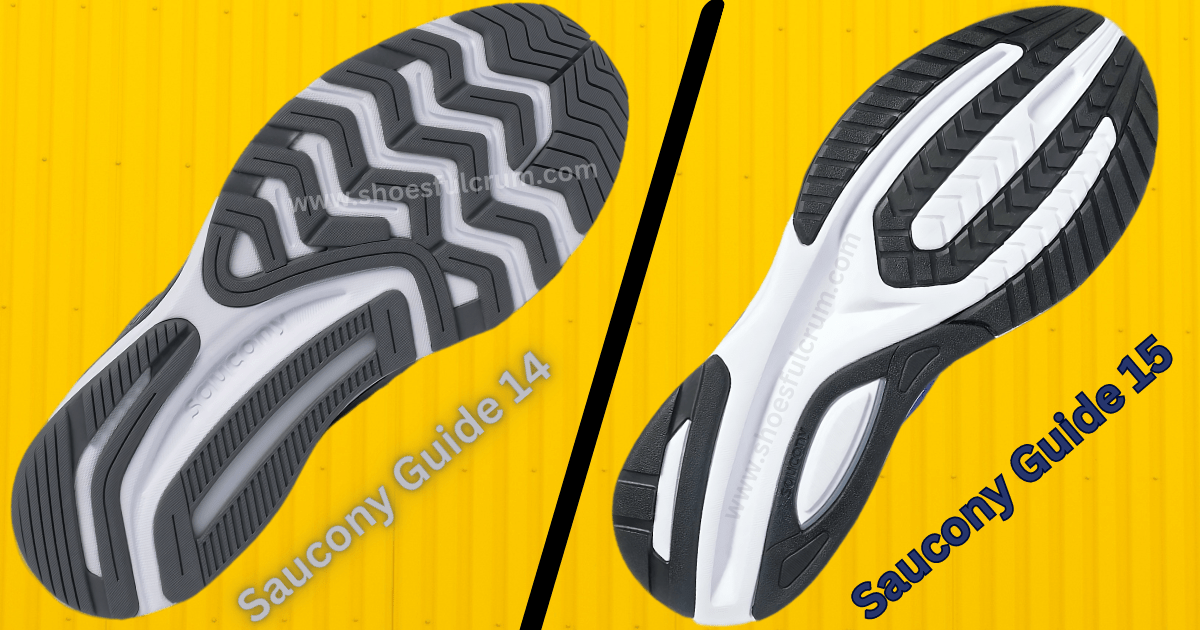
The outsole of a running shoe plays a crucial role in providing traction and durability, ensuring a secure grip on various surfaces.
Let’s see how both shoes perform in this category.
Tri-Flex Design
Saucony Guide 14
The Guide 14 features a durable rubber outsole with a Tri-Flex design.
This design incorporates a network of flex grooves that provide multi-directional flexibility and traction.
The flex grooves allow the shoe to move with the natural motion of your foot, promoting a smoother and more responsive ride.
Saucony Guide 15
Continuing the legacy of its predecessor, the Saucony Guide 15 features an outsole design that prioritizes traction and durability. The improvements in Guide 15’s outsole contribute to enhanced performance and stability during your runs.
The Guide 15 utilizes a durable rubber outsole with a Tri-Flex configuration. This configuration includes flex grooves that offer optimal flexibility and traction.
Just like Grid 14, its flex grooves also ensure that the shoe moves harmoniously with your foot, promoting a more natural and efficient stride.
Lugs
Saucony Guide 14
The strategically placed lugs on the outsole of Guide 14 enhance traction and grip on different surfaces.
Whether you’re running on roads, sidewalks, or light trails, the lugs provide reliable traction, reducing the risk of slipping or sliding.
Saucony Guide 15
The lugs on the outsole of the Guide 15 provide a reliable grip on various surfaces.
They offer traction and stability, allowing you to confidently navigate different terrains. Whether you encounter wet roads, gravel paths, or uneven surfaces, the Guide 15’s outsole ensures a secure footing.
Rubber Compound
Saucony Guide 14
The rubber compound used in the outsole of the Guide 14 is designed for durability, ensuring that the shoe can withstand the rigors of your training sessions.
The sturdy design of the outsole contributes to the overall durability of the shoe, enabling you to enjoy extensive running for many miles without compromising its quality.
Saucony Guide 15
The rubber compound used in Guide 15’s outsole is designed to withstand the demands of running. It offers excellent durability, allowing you to enjoy extended mileage without significant wear and tear.
Important Point
Both the Saucony Guide 14 and 15 feature outsole designs that prioritize traction and durability.
The Tri-Flex configurations and rubber compounds used in both models provide reliable grip and longevity.
In my experience, whether you choose Guide 14 or 15, you can expect a secure and stable ride across various running surfaces.
Fit Options And Sizing Of Saucony Guide 14 VS 15

Ensuring a proper fit when selecting a running shoe is crucial as it directly impacts your comfort, provides the necessary support, and facilitates optimal performance during your runs.
Saucony Guide 14
The Saucony Guide 14 offers a range of fit options to accommodate different foot shapes and sizes.
- The Guide 14 is available in both men’s and women’s versions, with specific variations in sizing and width options.
- This ensures a more customized fit based on gender-specific foot anatomy. It is important to note that Guide 14 follows standard sizing conventions, so it is recommended to consult the Saucony sizing chart to find the most accurate fit.
- In terms of width options, the Saucony Guide 14 offers variations such as regular width (D for men and B for women) and wide width (2E for men and D for women).
- The availability of different width options caters to those with wider feet, allowing for a more comfortable and accommodating fit.
Saucony Guide 15
Building upon the success of its predecessor, the Saucony Guide 15 introduces enhancements in fit options to provide an even better-fit experience. These improvements aim to cater to a wider range of foot shapes and sizes.
- Similar to Guide 14, Guide 15 is available in men’s and women’s versions with specific sizing and width options.
- However, Guide 15 introduces a new addition to its fit options: the “Wide+” width for men. This width option is designed to provide an even roomier fit for those with wider feet, ensuring maximum comfort and support.
- It is important to note that the Saucony Guide 15 follows the same standard sizing conventions as its predecessor. To find the ideal fit, I would recommend you consult the Saucony sizing chart and consider any specific foot characteristics or preferences.
Impact Of Fit Options On Comfort And Performance
Having the right fit in your running shoes can significantly impact your comfort and overall running experience. The fit options available in the Saucony Guide 14 and 15 play a crucial role in achieving a comfortable fit that enhances performance.
A proper fit ensures that your foot is securely held in place within the shoe, preventing excessive movement and potential discomfort. It allows for an optimal balance between snugness and roominess, accommodating the natural expansion and movement of your feet during running.
A comfortable fit contributes to better stability and support, reducing the risk of injuries and enhancing your overall performance. When your shoes fit properly, you can maintain a more efficient stride, resulting in improved running mechanics and less fatigue.
Stability And Pronation Control In The Saucony Guide 14 VS 15
Stability is a crucial aspect of running shoes, especially for those who overpronate or require additional support during their runs.
Stability and Pronation Control in the Saucony Guide 14

- The Saucony Guide 14 is specifically designed to provide stability and pronation control, catering to a wide range of runners’ needs.
- Guide 14 features a medial post in the midsole, a firmer section of the foam. This medial post helps reduce excessive inward rolling of the foot, commonly known as overpronation.
- By controlling pronation, Guide 14 promotes a more efficient and balanced stride, minimizing the risk of injuries associated with overpronation.
- Additionally, Guide 14 utilizes a TPU (thermoplastic polyurethane) guidance frame to enhance stability. This guidance frame is integrated into the midsole and extends from the heel to the midfoot. It provides structure and support to prevent unwanted foot movements, ensuring a stable platform for runners.
- The combination of the medial post and the guidance frame in the Saucony Guide 14 offers a supportive and stable ride, particularly beneficial for runners with mild to moderate overpronation tendencies.
Advancements In Stability And Pronation Control In The Saucony Guide 15

Building upon the success of its predecessor, the Saucony Guide 15 introduces advancements in stability and pronation control. These enhancements aim to provide a more supportive and stable running experience for runners with different foot types and pronation needs.
- In Guide 15, Saucony incorporates an updated version of the TPU guidance frame. The guidance frame in Guide 15 is strategically engineered to provide improved stability while maintaining a lightweight and flexible design.
- The updated frame offers enhanced support to guide the foot through a more efficient and controlled gait cycle.
- Another notable advancement in the Guide 15 is adding a new technology called the PWRFOAM+. This new cushioning technology is specifically engineered to deliver a balance of cushioning and responsiveness while still providing stability.
- The PWRFOAM+ works in conjunction with the guidance frame to offer a smooth and controlled ride, accommodating a variety of foot types and pronation patterns.
- These advancements in stability and pronation control in the Saucony Guide 15 contribute to a more secure and supportive running experience. These shoes offer runners the assurance and steadiness required to perform at their peak, irrespective of their foot type or preferred running style.
Level Of Support And Stability For Different Foot Types And Running Styles
The level of support and stability provided by the Saucony Guide 14 and 15 can vary depending on your foot types and running styles.
The stability features and pronation control mechanisms in both models aim to address the needs of different runners.
Mild To Moderate Overpronation
For those with mild to moderate overpronation, Guides 14 and 15 offer effective support and stability.
The medial post and the guidance frame work together to control pronation and provide a secure platform for the foot, reducing the risk of excessive inward rolling.
Severe Overpronation
It is important to note that the level of stability provided by Guides 14 and 15 may not be ideal for runners with severe overpronation or those in need of maximum motion control. In such cases, I highly recommend you consult with a healthcare professional or a specialized running store to explore more suitable options.
Furthermore, the Saucony Guide 14 and 15 can provide stability and support for different running styles.
Whether you are a casual runner or an experienced athlete, the stability features in both models contribute to a more controlled and efficient stride, enhancing overall running performance.
Impact Of Stability Features On Injury Prevention And Running Efficiency
The stability features in the Saucony Guide 14 and 15 play a vital role in injury prevention and overall running efficiency.
By addressing overpronation and providing a stable platform, these features help minimize the risk of common running injuries associated with excessive foot movement.
The stability features in Guides 14 and 15 work to mitigate these risks by promoting proper foot alignment and reducing the stress placed on vulnerable areas.
Additionally, the stability provided by Guides 14 and 15 contributes to improved running efficiency.
When the foot is properly supported and guided through the gait cycle, energy is used more efficiently, resulting in a smoother and more effortless stride.
This can translate into better performance and reduced fatigue, allowing runners to go the extra mile.
Weight Comparison Of Saucony Guide 14 VS 15
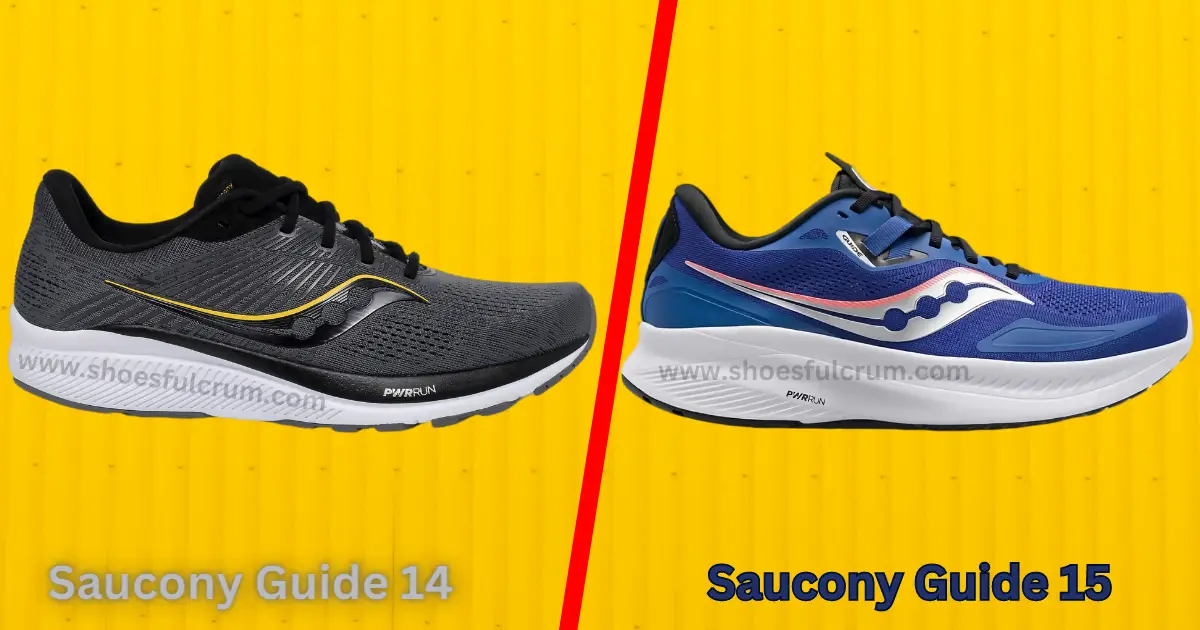
When it comes to running shoes, weight plays a significant role in determining the overall performance and running experience.
Saucony Guide 14
The Saucony Guide 14 strikes a balance between cushioning and responsiveness while maintaining a moderate weight.
The Guide 14 is designed to be a supportive and stability-oriented running shoe, which inherently adds a bit of weight compared to lighter, minimalist models.
However, this added weight contributes to the shoe’s stability and durability, providing a solid foundation for runners.
While the Guide 14 is not the lightest shoe on the market, it offers ample cushioning and support without sacrificing responsiveness.
The moderate weight ensures a comfortable and protective feel, especially during longer runs or high-impact activities.
Saucony Guide 15
In the Saucony Guide 15, advancements have been made to reduce weight without compromising on stability and durability.
The engineers at Saucony have utilized innovative materials and design techniques to create a lighter and more responsive running shoe.
In comparison to its previous model, the Guide 15 offers a slightly lower weight, which makes it a more attractive choice for runners who desire a lighter and swifter sensation during their runs.
The weight reduction is achieved through the use of lighter materials in the upper and midsole, without compromising on the shoe’s supportive features.
Benefits Of Lighter Shoes
Weight reduction has several significant benefits for runners.
- Firstly, a lighter shoe can contribute to improved running efficiency and faster times. The reduced weight means less energy is required to propel the foot forward, which allows for a more effortless and efficient stride.
- Secondly, a lighter shoe can reduce the strain and fatigue on the legs and feet during long-distance runs. Runners can experience less muscle fatigue and overall discomfort, enabling them to maintain their pace and endurance over extended periods.
Waterproofness Of Saucony Guide 14 VS 15

Having a shoe with waterproof capabilities can greatly impact your running experience, especially when you encounter various weather conditions. While the Saucony Guide 14 and Guide 15 are not specifically designed as waterproof shoes, they do offer certain water-resistant features that can help protect your feet during wet conditions.
Let’s explore the waterproofness aspects of both models.
Saucony Guide 14
The Saucony Guide 14 incorporates water-resistant properties to help keep your feet dry in light rain or damp conditions.
The upper of Guide 14 utilizes a combination of engineered mesh and synthetic overlays that have a degree of water repellency.
These materials are created to keep water droplets away, effectively stopping them from seeping into and getting inside the shoe.
While Guide 14 is not completely waterproof, it provides a level of protection against light moisture, ensuring that your feet stay relatively dry and comfortable during short rain showers or wet terrains.
Important Note
It’s important to note that the water-resistant properties of Guide 14 may diminish over time with wear and repeated exposure to water. Therefore, I recommend you reapply for a water-repellent treatment periodically to maintain the shoe’s water-resistant capabilities.
Saucony Guide 15
Building upon the water-resistant features of its predecessor, the Saucony Guide 15 introduces an enhanced water-resistant design.
The upper of Guide 15 incorporates advanced materials and construction techniques to provide a higher level of water repellency.
The engineered mesh and synthetic overlays of Guide 15 are treated with a DWR (Durable Water Repellent) coating, which enhances the shoe’s ability to repel water and keep your feet drier in wet conditions.
This improved water-resistant design offers increased protection against light rain, puddles, and wet terrains.
Important Note
While Guide 15 provides better water resistance compared to Guide 14, it’s important to note that it is still not fully waterproof. Extended exposure to heavy rain or submerging the shoe in water can compromise its water-resistant capabilities.
It’s always a good idea to avoid excessive water exposure and wear appropriate waterproof gear for extreme weather conditions.
Waterproofness Considerations
It’s essential to understand the distinction between water resistance and waterproofness.
Shoes that are resistant to water, like Guide 14 and Guide 15, are made to keep water away to some extent, but they are not completely invulnerable to moisture.
Conversely, waterproof shoes offer a higher level of protection against water penetration, providing enhanced resistance to keep your feet dry.
If you frequently run in extremely wet conditions or require full waterproofness, it may be worth considering dedicated waterproof running shoes or additional waterproofing treatments.
These options can provide a higher level of assurance and keep your feet dry and comfortable in more challenging weather conditions.
Important Note
It’s also worth noting that while water-resistant features are beneficial, they may affect the breathability of the shoe.
In some cases, increased water resistance can compromise airflow and ventilation, leading to a slightly warmer and less breathable running experience.
I suggest considering your specific needs and preferences when evaluating the waterproof features of running shoes.
Pros And Cons: Saucony Guide 14 VS 15
Both shoes have the following Pros and Cons.
Saucony Guide 14
| Pros | Cons |
|---|---|
| Stability | Heavyweight |
| Cushioning | Limited Color Options |
| Supportive Fit | Moderate Flexibility |
| Durability | |
| Responsive Ride | |
| Breathable Upper | |
| Versatile Performance |
Saucony Guide 15
| Pros | Cons |
|---|---|
| Lightweight | Limited Arch Support |
| Enhanced Cushioning | Narrow Toe Box |
| Improved Fit | Reduced Ground Feel |
| Responsive Midsole | |
| Breathable Design | |
| Reliable Traction | |
| Enhanced Water Resistance |
Conclusion
After a detailed comparison of Saucony Guide 14 VS 15, it is clear that both the Saucony Guide 14 and Guide 15 offer exceptional features and performance for runners. The Guide 14 provides a stable and durable running experience with its supportive fit and responsive cushioning.
However, Guide 15 brings forth innovations in reducing weight, enhancing comfort, and upgrading water resistance, which makes it an excellent choice for those looking for a shoe that is light in weight and adaptable in various situations.
Whether you choose Guide 14 or Guide 15, you can expect a reliable and comfortable running companion. Both models excel in their respective areas, catering to different preferences and needs. The Guide 14 is a tried-and-true choice for runners who prioritize stability and durability, while the Guide 15 offers a more lightweight and responsive feel with added water resistance.
Whichever shoe you choose, the Saucony Guide series is designed to enhance your running experience and support you on your fitness journey. So lace up, hit the road, and enjoy the miles ahead with confidence and comfort in your Saucony Guides.
Frequently Asked Questions
Are the Saucony Guide 14 and Guide 15 suitable for long-distance running?
Yes, both Guide 14 and Guide 15 are designed to provide support and comfort for long-distance running. Their cushioning, stability features, and durable construction make them reliable options for extended runs.
Can I use the Saucony Guide 14 and Guide 15 for other activities, like gym workouts or casual walking?
Absolutely! While primarily designed for running, Guide 14 and Guide 15 can be versatile companions for other activities, including gym workouts and casual walking. Their cushioning, stability, and overall comfort make them suitable for various low-impact exercises and everyday wear.
Do the Saucony Guide 14 and Guide 15 accommodate orthotics?
Certainly! Both models come with a detachable insole, which means you can swap it out with your personalized orthotics if necessary. This feature ensures that you can achieve the desired level of support and comfort based on your individual foot needs.
How do I clean and maintain my Saucony Guide 14 or Guide 15?
To keep your shoes clean, simply remove any loose dirt or debris gently and use a damp cloth to wipe them off. Avoid using harsh chemicals or abrasive cleaners, as they may damage the materials. Let your shoe air dry naturally. Regularly inspect and replace worn-out laces to maintain a secure fit.
Are the Saucony Guide 14 and Guide 15 suitable for runners with wide feet?
Both models offer options for runners with wider feet. Saucony provides different widths, including wide and extra-wide, to accommodate various foot shapes.

About Author:
Burhan Khan is a versatile writer, passionate about running, skating, and athletic footwear. He’s an authority on running shoes, offering detailed insights honed from personal participation in competitions. Burhan’s expertise spans major brands like Nike and Adidas to niche players such as Brooks and Saucony. His analyses dive deep into shoe design and technology, catering to diverse needs—from marathoners to novice runners. Beyond running, Burhan appreciates quality footwear in skating, evaluating brands like Vans and DC Shoes. His research ensures informed decisions for enhancing performance and enjoyment. Read more…

